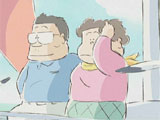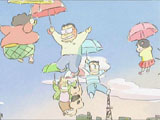

Quick Links:
My Neighbors, the Yamadas (Tonari no Yamada-kun)
I hear a lot of people refer to Mr. Hayao Miyazaki as the "wise old man" or grandfather of anime, but that never sat well with me. He's certainly old and wise in the ways of animation, but his work always showed a kind of childish innocence, and his image resists the label of "grandfather" because of it. If there's anybody I'd call a "wise old man" of anime, it would be Mr. Isao Takahata. While Miyazaki's films tend to appeal to children - or at least our inner child - Takahata's films tend to capture adult feelings and experiences. In My Neighbors the Yamadas, the topic is family life. It's for mature audiences, like Grave of the Fireflies and Only Yesterday, but it doesn't carry the emotional weight of those titles. Instead, it is lighthearted and funny. The film does a wonderful job at showing that some of the best comedy can be found in normal, everyday circumstances.
The Yamadas are five: Takashi, his mother-in-law Shige, wife Matsuko, son Noboru, and daughter Nonoko. The majority of the film touches on topics that crop up in most families, such as forgetfulness, what to make for dinner, studying, parent-child bonding, and so on. Almost all of these things is endlessly amusing, because we've all experienced the same things in our own families. It's that much funnier to see other families doing the same silly things, like fighting over the television, or playing tricks on family members to get out of doing chores.
The film would have felt too episodal, likely, if the small topics were all it covered. Everything comes together though, thanks to the wonderland of scenery that we're treated to in the opening and ending parts of the film. The beginning of the film is a speech made to newlyweds Takashi and Matsuko at their reception, covering the trials of marriage and the reasons to pass those trials. This segment of the film introduces its theme song, a happy-go-lucky song that shows up often during the film and while the credits are rolling. The scenery matches the symbolism used in the speech, and together with the music, it works beautifully. (The births of Noboru and Nonoko are particularly amusing, because they allude to the old folk tales of Momotaro and Kaguya-Hime.)
The ending of the movie is a festive encore, with a Japanese-language version of Doris Day's immortal Que Sera, Sera playing in the background. As the choice of song may suggest, these final scenes celebrate taking life as it comes, without worry of the future. The animation definitely uses the waltz to its advantage, with characters swaying to the music and floating above their worries. The whole film is enjoyable, but it is these opening and ending segments where Ghibli's excellence in animation shines through.
My Neighbors the Yamadas distinguishes itself from the other Ghibli movies by its unique art style. The drawings are simplistic in nature, but sport brilliant colorings that have the softness of watercolor and the shine of latex. By the way, the animation production and coloring were 100% digital. This film was Ghibli's first computer-made feature-length animation, and I hope they do more of them.
When all is said and done, Mr. Takahata will be better known for Grave of the Fireflies than this film. But to me, Yamadas is far and away his most enjoyable film. Family life is simplistic, yet unpredictable - creating some surprisingly funny situations. Also, its unique art style makes for a one-of-a-kind visual experience. Watch it, if you can get the remote control away from the old man.
Distributor: Disney Creator: Isao Takahata / Studio Ghibli Released: 1999
Plot: A+ Character Design: B+ Animation Quality: A Music: A Overall: A



